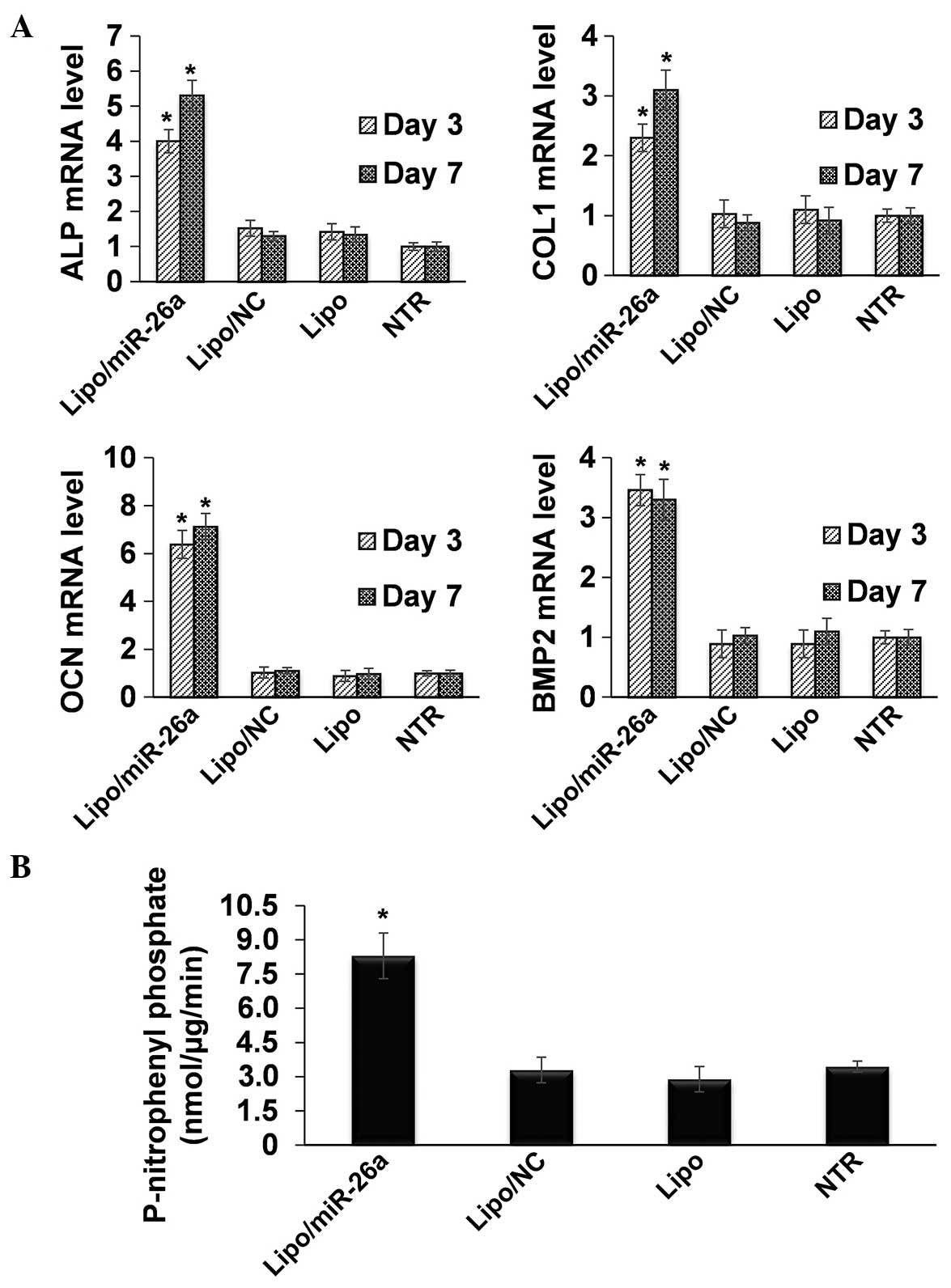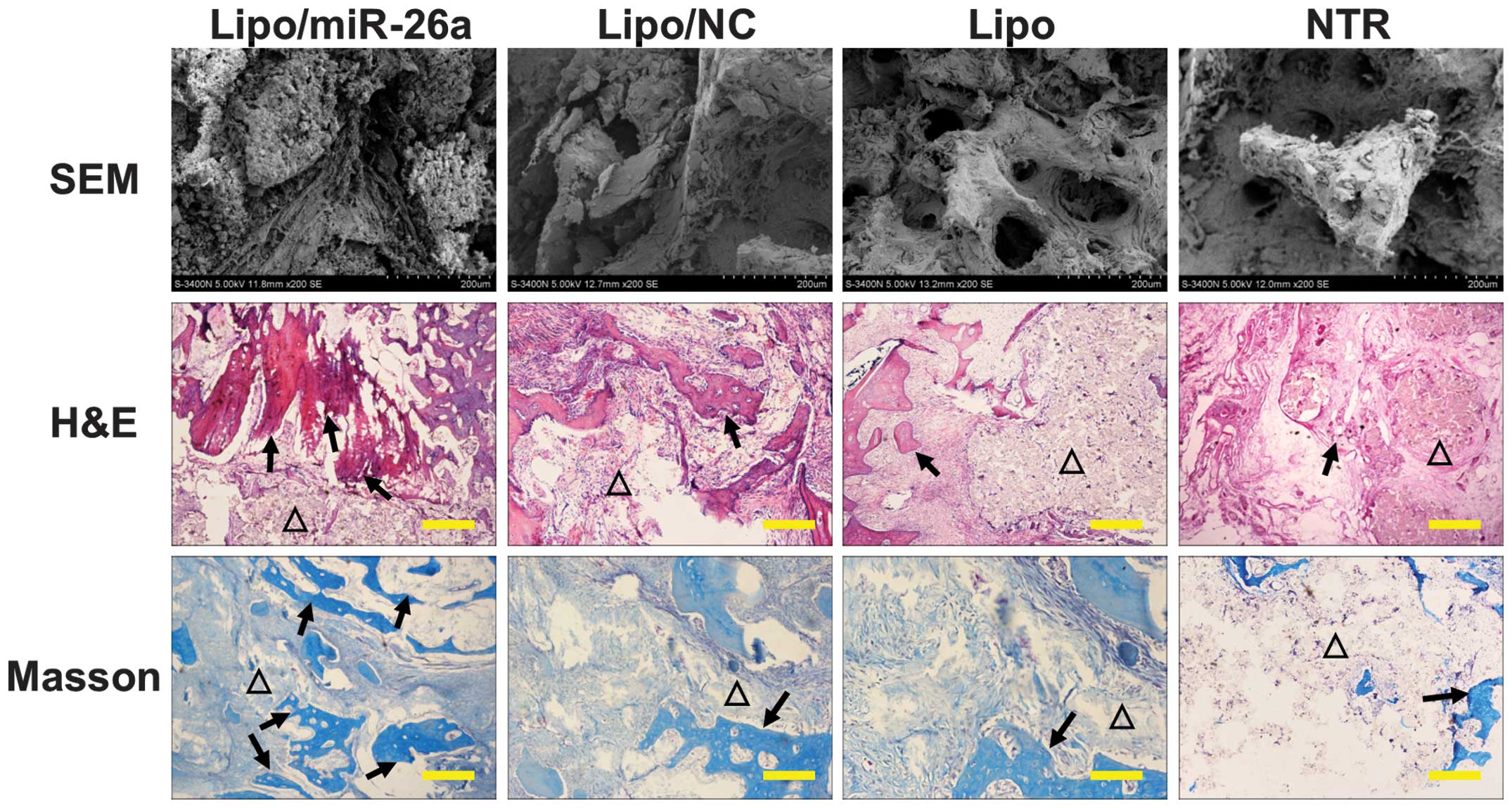|
1
|
Wiese A and Pape HC: Bone defects caused
by high-energy injuries, bone loss, infected nonunions and
nonunions. Orthop Clin North Am. 41:1–4. 2010. View Article : Google Scholar
|
|
2
|
Nishida J and Shimamura T: Methods of
reconstruction for bone defect after tumor excision: A review of
alternatives. Med Sci Monit. 14:RA107–RA113. 2008.PubMed/NCBI
|
|
3
|
Spicer PP, Kretlow JD, Young S, Jansen JA,
Kasper FK and Mikos AG: Evaluation of bone regeneration using the
rat critical size calvarial defect. Nat Protoc. 7:1918–1929. 2012.
View Article : Google Scholar : PubMed/NCBI
|
|
4
|
Kundu B, Soundrapandian C, Nandi SK, et
al: Development of new localized drug delivery system based on
ceftriaxone-sulbactam composite drug impregnated porous
hydroxyapatite: A systematic approach for in vitro and in vivo
animal trial. Pharm Res. 27:1659–1676. 2010. View Article : Google Scholar : PubMed/NCBI
|
|
5
|
Tian HT, Zhang B, Tian Q, Liu Y, Yang SH
and Shao ZW: Construction of self-assembled cartilage tissue from
bone marrow mesenchymal stem cells induced by hypoxia combined with
GDF-5. J Huazhong Univ Sci Technolog Med Sci. 33:700–706. 2013.
View Article : Google Scholar : PubMed/NCBI
|
|
6
|
Zhao J, Yang C, Su C, et al:
Reconstruction of orbital defects by implantation of antigen-free
bovine cancellous bone scaffold combined with bone marrow
mesenchymal stem cells in rats. Graefes Arch Clin Exp Ophthalmol.
251:1325–1333. 2013. View Article : Google Scholar : PubMed/NCBI
|
|
7
|
Fraser J, Zhu M, Wulur I and Alfonso Z:
Adipose-derived stem cells. Mesenchymal Stem Cells. Prockop D,
Bunnell B and Phinney D: 449. Human Press; pp. 59–67. 2008,
View Article : Google Scholar
|
|
8
|
Gómez-Lechón M and Tolosa L: Hepatogenic
differentiation: Comparison between adipose tissue-derived stem
cells and bone marrow mesenchymal stem cells. Stem Cells and Cancer
Stem Cells. Hayat MA: 10. Springer; Netherlands: pp. 45–57.
2013
|
|
9
|
Marappagounder D, Somasundaram I, Dorairaj
S and Sankaran R: Differentiation of mesenchymal stem cells derived
from human bone marrow and subcutaneous adipose tissue into
pancreatic islet-like clusters in vitro. Cell Mol Biol Lett.
18:75–88. 2013. View Article : Google Scholar
|
|
10
|
Zhu X, Shi W, Tai W and Liu F: The
comparition of biological characteristics and multilineage
differentiation of bone marrow and adipose derived Mesenchymal stem
cells. Cell Tissue Res. 350:277–287. 2012. View Article : Google Scholar : PubMed/NCBI
|
|
11
|
Arrigoni E, de Girolamo L, Di Giancamillo
A, et al: Adipose-derived stem cells and rabbit bone regeneration:
Histomorphometric, immunohistochemical and mechanical
characterization. J Orthop Sci. 18:331–339. 2013. View Article : Google Scholar : PubMed/NCBI
|
|
12
|
Mohan BG, Suresh Babu S, Varma HK and John
A: In vitro evaluation of bioactive strontium-based ceramic with
rabbit adipose-derived stem cells for bone tissue regeneration. J
Mater Sci Mater Med. 24:2831–2844. 2013. View Article : Google Scholar : PubMed/NCBI
|
|
13
|
Hao W, Dong J, Jiang M, Wu J, Cui F and
Zhou D: Enhanced bone formation in large segmental radial defects
by combining adipose-derived stem cells expressing bone
morphogenetic protein 2 with nHA/RHLC/PLA scaffold. Int Orthop.
34:1341–1349. 2010. View Article : Google Scholar : PubMed/NCBI
|
|
14
|
Song W, Wu K, Yan J, Zhang Y and Zhao L:
MiR-148b laden titanium implant promoting osteogenic
differentiation of rat bone marrow mesenchymal stem cells. RSC
Advances. 3:11292–11300. 2013. View Article : Google Scholar
|
|
15
|
Wu K, Song W, Zhao L, et al: MicroRNA
functionalized microporous titanium oxide surface by lyophilization
with enhanced osteogenic activity. ACS Appl Mater Interfaces.
5:2733–2744. 2013. View Article : Google Scholar : PubMed/NCBI
|
|
16
|
Li Y, Fan L, Liu S, et al: The promotion
of bone regeneration through positive regulation of
angiogenic-osteogenic coupling using microRNA-26a. Biomaterials.
34:5048–5058. 2013. View Article : Google Scholar : PubMed/NCBI
|
|
17
|
Pieri F, Lucarelli E, Corinaldesi G, et
al: Dose-dependent effect of adipose-derived adult stem cells on
vertical bone regeneration in rabbit calvarium. Biomaterials.
31:3527–3535. 2010. View Article : Google Scholar : PubMed/NCBI
|
|
18
|
Xu W, Ganz C, Weber U, et al: Evaluation
of injectable silica-embedded nanohydroxyapatite bone substitute in
a rat tibia defect model. Int J Nanomedicine. 6:1543–1552. 2011.
View Article : Google Scholar : PubMed/NCBI
|
|
19
|
Wang X, Liu C, Li S, et al: Effects of
continuous passage on immunomodulatory properties of human
adipose-derived stem cells. Cell Tissue Bank. 16:143–150. 2015.
View Article : Google Scholar
|
|
20
|
Carthew RW and Sontheimer EJ: Origins and
mechanisms of miRNAs and siRNAs. Cell. 136:642–655. 2009.
View Article : Google Scholar : PubMed/NCBI
|
|
21
|
Yau WW, Rujitanaroj PO, Lam L and Chew SY:
Directing stem cell fate by controlled RNA interference.
Biomaterials. 33:2608–2628. 2012. View Article : Google Scholar : PubMed/NCBI
|
|
22
|
Rose FR, Cyster LA, Grant DM, Scotchford
CA, Howdle SM and Shakesheff KM: In vitro assessment of cell
penetration into porous hydroxyapatite scaffolds with a central
aligned channel. Biomaterials. 25:5507–5514. 2004. View Article : Google Scholar : PubMed/NCBI
|
|
23
|
Masuyama R, Nakaya Y, Katsumata S, et al:
Dietary calcium and phosphorus ratio regulates bone mineralization
and turnover in vitamin D receptor knockout mice by affecting
intestinal calcium and phosphorus absorption. J Bone Miner Res.
18:1217–1226. 2003. View Article : Google Scholar : PubMed/NCBI
|
|
24
|
Koshihara M, Masuyama R, Uehara M and
Suzuki K: Effect of dietary calcium: Phosphorus ratio on bone
mineralization and intestinal calcium absorption in ovariectomized
rats. Biofactors. 22:39–42. 2004. View Article : Google Scholar
|
|
25
|
D'Antonio JA, Capello WN and Jaffe WL:
Hydroxylapatite-coated hip implants. Multicenter three-year
clinical and roentgenographic results. Clin Orthop Relat Res.
285:102–115. 1992.PubMed/NCBI
|
|
26
|
Ghanaati SM, Thimm BW, Unger RE, et al:
Collagen-embedded hydroxylapatite-beta-tricalcium phosphate-silicon
dioxide bone substitute granules assist rapid vascularization and
promote cell growth. Biomed Mater. 5:250042010. View Article : Google Scholar : PubMed/NCBI
|
|
27
|
Lima PA, Resende CX, Soares GD, Anselme K
and Almeida LE: Preparation, characterization and biological test
of 3D-scaffolds based on chitosan, fibroin and hydroxyapatite for
bone tissue engineering. Mater Sci Eng C Mater Biol Appl.
33:3389–3395. 2013. View Article : Google Scholar : PubMed/NCBI
|













